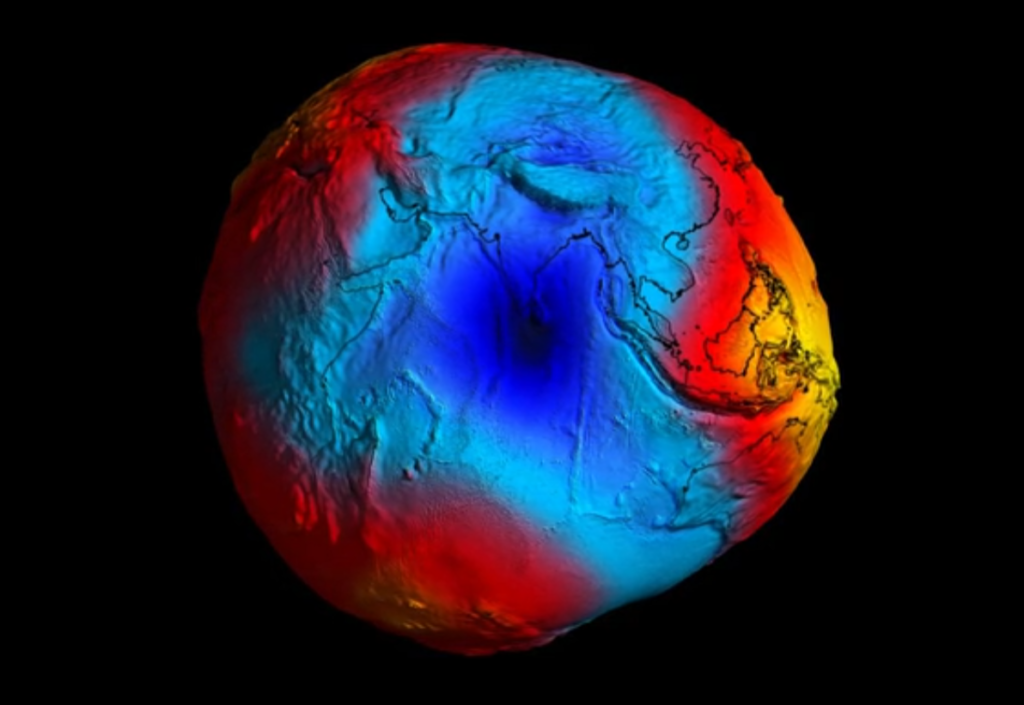Earth is full of incredible phenomena, and science continues to uncover its hidden marvels. Let’s explore 10 captivating facts about our unique planet, enriched by modern research and satellite insights.

1. Earth’s Shape: Not a Perfect Sphere
While Earth looks like a sphere from space, it’s slightly flattened at the poles and bulges at the equator. This unique shape, called an oblate spheroid, results from Earth’s rotation and uneven mass distribution. These characteristics create minor variations in gravity at different points on the planet, which are imperceptible to the human eye but measurable by satellites.
Satellite data from ESA’s GOCE mission reveals Earth’s “geoid,” a gravitationally shaped surface that influences sea levels and provides vital data for geophysical studies. This geoid helps scientists understand ocean circulation, plate tectonics, and other dynamic processes shaping our planet.
Understanding Earth’s shape is more than academic curiosity. It influences navigation systems, satellite trajectories, and even climate models, making it a cornerstone of modern Earth sciences.

2. Coral Reefs: Nature’s Largest Living Structures
Coral reefs, formed by colonies of tiny coral polyps, are the largest living structures on Earth, spanning over 284,000 square kilometers globally. These ecosystems not only dazzle with their beauty but also provide shelter and sustenance to countless marine species, acting as critical hubs of biodiversity.
The Great Barrier Reef, the world’s largest coral reef system, demonstrates the vital role reefs play in ocean health and coastal protection. Coral reefs also mitigate storm impacts by acting as natural barriers, reducing coastal erosion and safeguarding human settlements.
However, these vibrant ecosystems face significant threats from climate change. Ocean acidification, rising sea temperatures, and pollution are causing widespread coral bleaching. ESA satellites help monitor these changes, offering insights crucial for conservation efforts to preserve these underwater treasures.

3. Earth’s Interior Is Surprisingly Fluid
Beneath the crust lies a dynamic mantle of semi-solid rock that flows over geological timescales. This “squishy” layer drives processes like plate tectonics, volcanic eruptions, and earthquakes, reshaping Earth’s surface continuously.
A striking example of the mantle’s influence is post-glacial rebound, where land rises after being compressed by glaciers during the last ice age. This phenomenon continues today, with regions like Scandinavia and Canada still rebounding from ancient ice coverage.
ESA’s GOCE mission has tracked subtle land movements, offering insights into Earth’s interior behavior and how surface changes affect ecosystems and human infrastructure. Understanding this fluid interior is key to predicting geological hazards and managing their impacts.

4. Antarctica: Guardian of Freshwater
Antarctica, the coldest continent, holds 70% of Earth’s freshwater locked within its vast ice sheet. Spanning 14 million square kilometers, this icy expanse influences global sea levels and ocean currents, making its stability critical for the planet.
Temperatures in Antarctica can plummet to -89.2°C, and winds reach over 320 km/h, yet this frozen land is vital to Earth’s climate. Satellite missions like ESA’s CryoSat monitor changes in ice thickness and flow, providing essential data on how warming temperatures affect polar ice.
Collaborative research with NASA and BAS enhances our understanding of Antarctic ice dynamics, guiding policy decisions to address sea-level rise and climate change.

5. The Moon: Slowly Saying Goodbye
The Moon drifts about 4 cm farther from Earth each year, altering tidal patterns and Earth’s rotation over millennia. This phenomenon results from gravitational interactions that create tidal bulges, gradually pushing the Moon outward.
The “giant impact” theory explains the Moon’s origin, suggesting it formed from debris after a colossal collision billions of years ago. This celestial dance, though slow, highlights the intricate relationship between Earth and its satellite.
Interestingly, Australia is wider than the Moon, spanning nearly 4,000 km compared to the Moon’s 3,400 km diameter. Despite its size, the Moon’s influence on Earth’s tides and ecosystems remains profound.

6. The Atacama: Earth’s Driest Desert
Chile’s Atacama Desert, with annual rainfall below 1 mm, is the driest non-polar region on Earth. Its extreme aridity results from a combination of geographical factors, including its location in a rain shadow and proximity to the cold Humboldt Current.
Despite harsh conditions, the Atacama supports unique life forms adapted to its environment. These include salt-loving microbes and hardy desert plants. The region’s alien landscape has even served as a testing ground for Mars exploration technologies.
Satellite observations help scientists study the Atacama’s geological features and track changes in this extreme ecosystem, revealing the resilience of life under challenging conditions.
7. Magnetic Poles on the Move
Earth’s magnetic poles wander due to dynamic changes in the molten core. The magnetic North Pole, once centered in Canada, is now sprinting toward Siberia at a rate of 50-60 km per year.
ESA’s Swarm satellites monitor these shifts, offering insights into Earth’s magnetic field and its protective role against solar radiation. Understanding these movements is critical for navigation, wildlife migration, and studying the effects of geomagnetic changes on technology.
This rapid drift underscores the dynamic nature of Earth’s interior and its far-reaching implications for both natural systems and human activities.

8. Europe’s Contrasting Scale and Population Density
Europe, the second smallest continent, is home to over 746 million people, making it the third largest by population. Its high urbanization rate poses challenges for sustainable development and resource management.
ESA’s World Settlement Footprint, derived from Sentinel missions, offers comprehensive data on human settlements. This tool aids urban planners in addressing issues like air pollution, energy use, and climate resilience.
Efforts to understand Europe’s population dynamics are crucial as global urbanization accelerates, requiring innovative solutions for sustainable living.

9. Tibetan Plateau: The Third Pole
The Tibetan Plateau, often called the “third pole,” holds the largest freshwater reserve outside the Arctic and Antarctic. Its glaciers feed major rivers like the Mekong and Yangtze, sustaining millions of people in Asia.
Climate change threatens these glaciers, accelerating melt rates and endangering water supplies. Recent studies reveal that Himalayan glacier loss has been underestimated, emphasizing the urgency of protective measures.
Satellite data highlights the plateau’s importance as a water source and its vulnerability, guiding efforts to preserve this vital ecosystem amid rising global temperatures.

10. Forests: The Lungs of Our Planet
Forests, covering 31% of Earth’s land, are vital carbon sinks, absorbing 8 gigatonnes of CO2 annually. They also harbor 80% of terrestrial biodiversity, making them indispensable for ecological balance.
Deforestation and climate change threaten these ecosystems, releasing stored carbon and reducing biodiversity. ESA’s Biomass mission measures forest carbon storage, providing data to inform conservation strategies.
Preserving and restoring forests is essential for combating climate change and ensuring the health of our planet’s ecosystems for future generations.
From shifting poles to coral reefs under threat, these remarkable Earth facts showcase the planet’s complexity and fragility. They also remind us of the urgent need for sustainable practices to preserve our shared home for future generations.